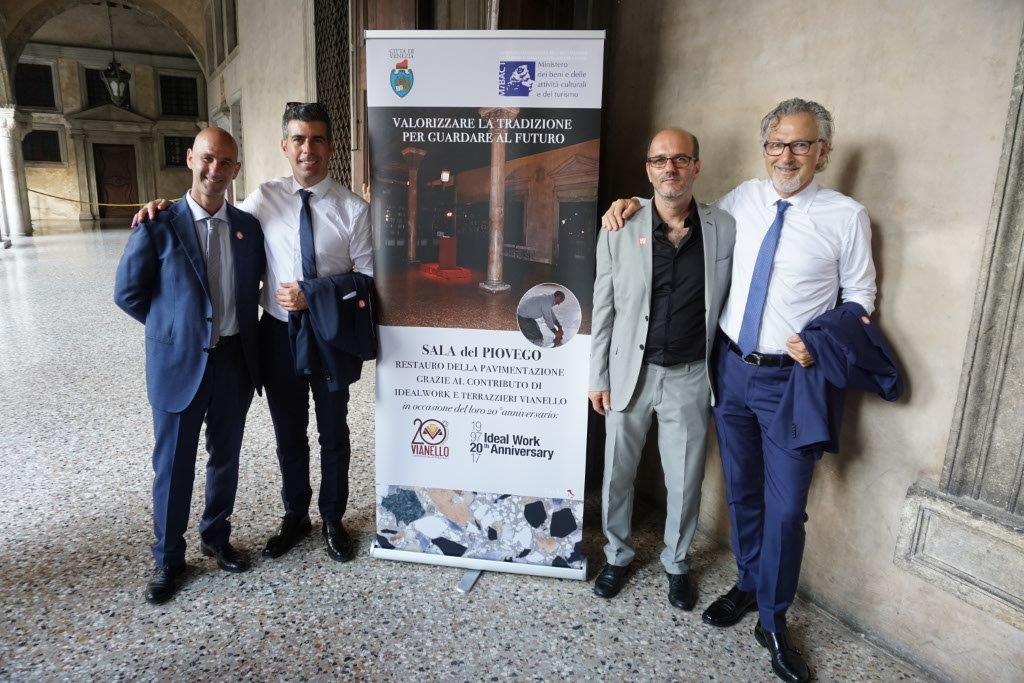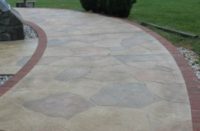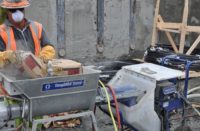I recently had the special opportunity to visit Venice by invitation of Italian-based Ideal Work, which was celebrating its 20th year in business.
I have known business partners Luca Seminati and Maurizio Pontello since I was invited to a training event at their place of business in Castelfranco Veneto a few years after the launch of Concrete Decor magazine in 2001. This initial visit to Ideal Work was an event that helped shape my perspective and thinking about an industry we call decorative concrete. And if it helps you to understand why, I’d say it has something to do with their dress code, their level of organization and a level of cleanliness that told me you could eat off the floors. These guys weren’t just in it for themselves; they were endeavoring to influence the world they lived in.

On our one-hour bus ride from Castelfranco Veneto to Venice yesterday, Luca looked at the ladies on their staff and complimented them by saying if they dressed so elegantly for work each day, business would double. However flattering that comment may have been, it’s not far from the truth. Ideal Work’s standards for excellence encompasses everything from the factory floor and shipping and receiving to sales, janitorial services and back to the administrative office.
How does this affect their business? I hope my other impressions of this visit answer this question.

When we arrived in Venice, we disembarked the water taxi and took a short walk along the waterfront to the granite column of The Lion of Venice where we were introduced to an English-speaking tour guide. Had she walked off a pier and into the ocean, I think any guy would have done the same as she was truly a gorgeous representative of Italian women. Along with the rest of the English-speaking foreigners, we gladly followed her into the courtyard of Doge’s Palace.


The scene was a bit confusing at first as the courtyard’s architecture was so contrasting. The palace had been restored and reconstructed countless times over the span of several centuries. It was built to suit the current ruler’s tastes and preferences without destroying intact features. Bits of Byzantine-Venetian architecture can still be seen alongside Gothic structures and Renaissance additions. One of the most impressive additions is an elaborate stone staircase flanked by enormous statues of Mars and Neptune signifying Venice’s power on land and sea.


When our small groups rejoined one another on a second-floor terrace for a glass of champagne, Luca introduced me to some of his other guests. Among them were four family members who were celebrating an anniversary of their own as caretakers of the palace’s Venetian-style terrazzo for the past 300 years. For obvious reasons, Luca proudly pointed out that many of this family’s projects in Venice today involve Ideal Work products.

This was not just a family of master-craftsmen whose years-old repairs are hard to detect. Their connection to Ideal Work, its products and people displayed an uncommon pride toward an industry that takes painstaking efforts to always exceed their customers high standards while upholding the family reputation. I think it’s the kind of grit the world recognizes as Venice.
A visit to Venice to experience some of this rich heritage may also explain why Bob Harris and John Anderson were led to develop the Paladiano “Wonders of the World” texture mats, a line of stamping tools offered by Solomon/Brickform. One of the stamps in the line replicates the ancient hand-cut stone placed in Venice centuries ago.
So how does a 20-year-old company find its way into projects of palatial caliber? It only comes with an unrelenting commitment to excellence and ongoing attention to detail. So while the Ideal Work ladies were quick to respond with outstretched hands to Luca’s comment about dressing to the nines, their implication was a jovial request for better pay in order to afford more dresses. The laughter told me that the entire staff already knew they were doing things right.
Back at Doge’s Palace, the wife of one of my new friends who lives and works in Venice pointed to three easily overlooked stones in the extraordinary terrazzo flooring. She said the green coloration of one stone is not used any place else in the palace as it wasn’t a color chosen for these floors centuries ago. However, that greenish colored stone together with similarly sized red and white stones beside it planted the Italian flag into the palace’s history.


We were privileged to be occupying this space as very few are allowed to enter the area. Continuing the history lesson, I also learned that two reddish-hued columns, often mistaken as weathered stone, flanked the area where the reigning doge addressed the people of Venice gathered in the palace plaza below. A deepening sense of awe consumed me. This iconic city was slowly unveiling the roots of an industry we are honored to call decorative concrete.

When we had had our fill of history for one day, we proceeded along the waterfront to the entrance of the palatial, five-star Hotel Danieli for a luxurious dinner. Sitting at a table with Ideal Work’s international guests that included my good friends Bob and Lee Ann Harris, we replenished our bodies with exceptional champagne, wines, water and great cuisine.


The evening was one to remember I thought as I enjoyed the water taxi ride out of the city. Then again, I believe that was Ideal Work’s intention. It’s how they have conducted themselves since the company’s inception.












